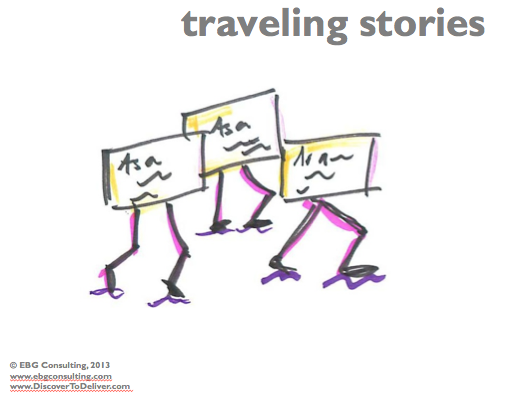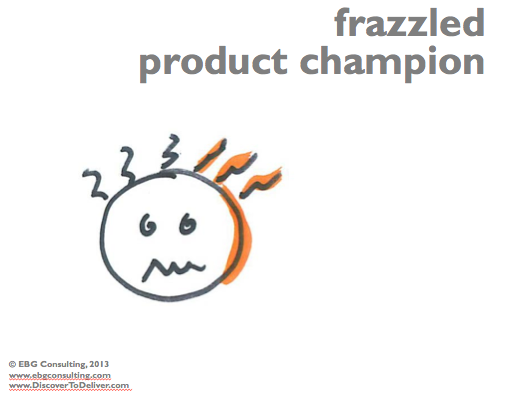Cure Your Agile Planning and Analysis Blues: The Top 9 Pain Points
If you’re on a team that’s transitioning to lean/agile, have you experienced troubling truths, baffling barriers, and veritable vexations around planning and analysis? We work with many lean/agile teams, and we’ve noted certain recurring planning and analysis pain points.
Mary Gorman and I shared our top observations in a recent webinar. Our hostess, Maureen McVey, IIBA’s Head of Learning and Development, prompted us to begin by sharing why we wrote the book Discover to Deliver: Agile Product Planning and Analysis and then explaining the essential practices you can learn by reading the book.
As we work with clients—product champions and delivery teams for both IT and commercial products—we strive to learn continually. And that learning is reflected in the book. It tells you how to take actions that will accelerate your delivery of valuable products and will increase your enjoyment in the work.
9 Pain Points to Prevent, Mitigate, or Resolve
Here’s what you need to know, in a nutshell — the nine pain points we most often see in planning and analysis. (Note: when you read “team,” it means the product partnership: business, customer, and technology stakeholders.)
Inadequate Analysis: Teams start to deliver and then realize they don’t know what not to build. Some teams, making a pendulum swing to agile, abandon analysis, trying so hard to go lightweight that they go “no weight.”
Poor Planning: Teams waste a lot of time in planning and meeting without first having a shared understanding of the product vision and goals or the product needs for the next delivery cycle. Planning might be taking too long, or, on some teams, the product champion and delivery team mistakenly think they have sufficient information to plan and deliver.
Frazzled Product Champion: The product champion (what Scrum calls the Product Owner)—the person who makes decisions about what to deliver and when—is frayed, frustrated, overwhelmed, and overstressed. These people, the keepers of the vision and the holders of political responsibility for the value of the product, often struggle mightily to balance their strategic product-related responsibilities with their tactical ones.
Bulging Backlog: Teams accumulate monster, huge backlogs (baselines) of requirements, often in the form of user stories. Every possible story or option for building the product is weighing down the backlog and squeezing or obscuring the highest-value stories.
Role Silos: The team members are acting according to their formal roles, and not focused on the goal. For example, someone always writes the stories, someone else does the testing, and someone else develops. They don’t have a shared way to communicate or a shared understanding of the product needs.
Blocked Team: Teams. Just. Get. Stuck. Waiting. On hold. It even happens to teams using high-end agile project management tools, which are supposed to help them stay organized and efficient. Some of these teams are overwhelmed by the plethora of requirements (see “Bulging Backlog”). Or they have unclear decision rules or don’t know how to define, quickly analyze, and act on value-based decisions. We’ve also observed teams with too few “fresh,” well-defined requirements, ready to pull into delivery.
Erroneous Estimates: Estimates are way off (dare I remind you, most of us underestimate our work). We’ve observed teams that, even after three or four iterations, can’t stabilize their cycle time or speed. Often, they lack clarity about complex business rules and data details, or about the product’s quality attributes (such as usability or performance). That often contributes to our next observation.
 Traveling Stories: Traveling stories (no, not traveling pants) are ones planned for a given iteration or release but end up being pushed to a later date. (As you may know, a story is a product need expressed as a user goal. Many agile teams use them, following the canonical format: “As a…I need to…so that…”) Occasionally stories travel due to unexpected technical issues. More often it’s because the stories are “too big” to be completed in a given release. Or at the last minute the team discovers they need an interface. Or they find expected business rules for an unexplored regulation. Or data dependencies pop up. Teams are not thin-slicing their stories based on value, and so they’re unable to finish.
Traveling Stories: Traveling stories (no, not traveling pants) are ones planned for a given iteration or release but end up being pushed to a later date. (As you may know, a story is a product need expressed as a user goal. Many agile teams use them, following the canonical format: “As a…I need to…so that…”) Occasionally stories travel due to unexpected technical issues. More often it’s because the stories are “too big” to be completed in a given release. Or at the last minute the team discovers they need an interface. Or they find expected business rules for an unexplored regulation. Or data dependencies pop up. Teams are not thin-slicing their stories based on value, and so they’re unable to finish.
Oops: Teams find unpleasant surprises during demonstrations and reviews, or weeks (or months) after delivery. Or worse, they aren’t delivering the right thing, the right value.
Context-Conversation-Collaboration: Pain Relief
You may have heard of card-conversation-confirmation, originated by Ron Jeffries and his coauthors. These “3C’s” explain the critical aspects of user stories, a part of the planning cycle.
Borrowing from Ron, we’ve found 3C’s of our own: agile product planning and analysis means attending to context, conversation, and collaboration. And these practices relieve the 9 pain points we’ve outlined.
Watch the Video
Hear more about our observations of development teams, learn about the underlying principles that we’ve seen work in all kinds of teams, and see how Mary and I integrated them into Discover to Deliver. The link to the video is here. Let us know what you think.
Troubling Truths, Baffling Barriers, and Veritable Vexations
What are your pain points around agile planning and analysis? Share them with us in our reply area, below.


Ellen, here at Boeing one of the biggest pain points I see recurring with Agile projects is the tendancy to convert to Agile to avoid all the reporting nightmares of the Traditional projects. This leads to some very specious reporting and lack of progress because the change management process has also been thrown out with the bath water. A second pain point is the Program and Portfolio reporting which, by its nature, needs to be somewhat standardized. So Agile projects increasingly take on Traditional Reporting to meet those requirements and it further hybridizes the Agile implementation.
Great list! I have one more to round it out to a list of ten. Meddlesome or Micro Management. When product owners aren’t fully empowered to make decisions and/or when development managers insert work into the sprint.